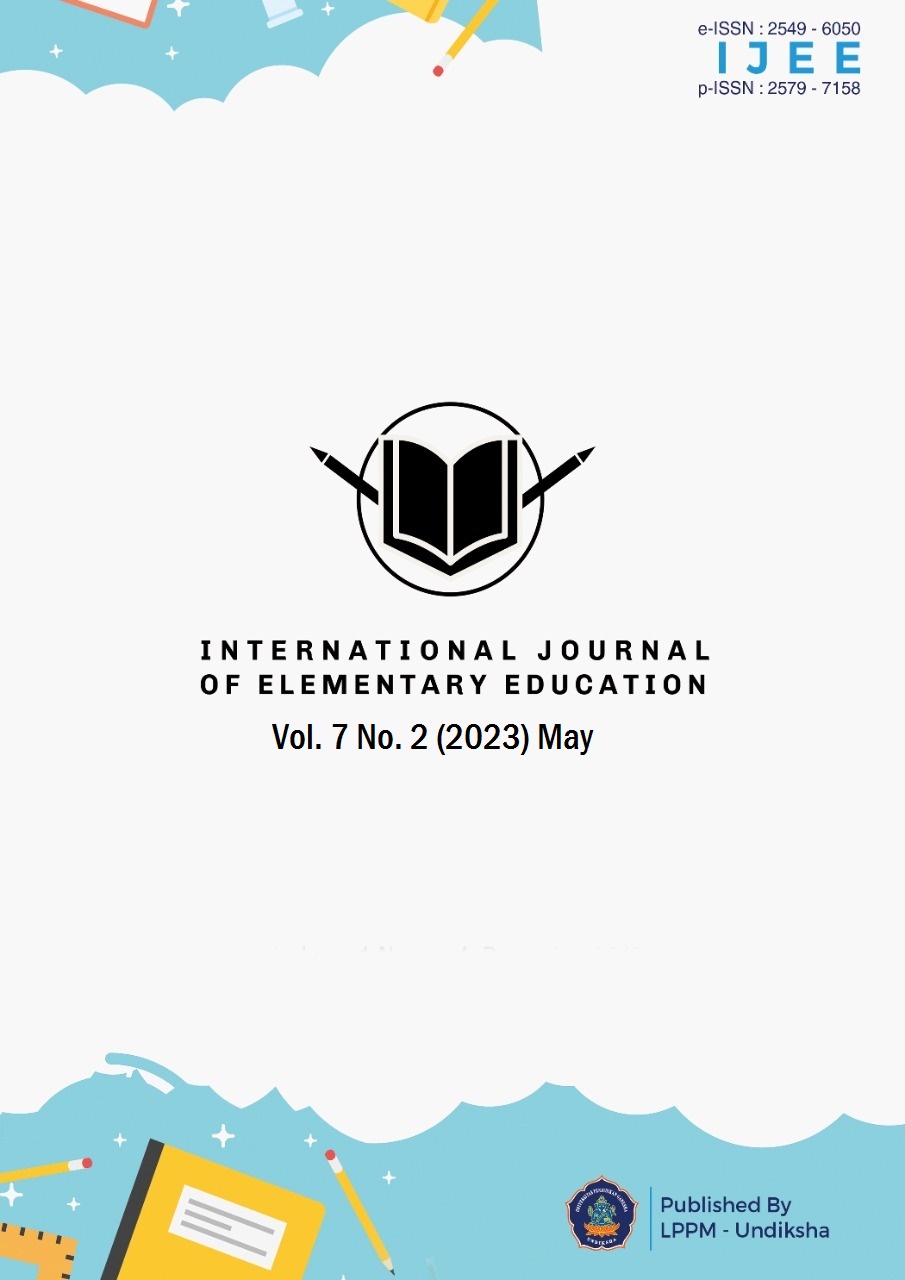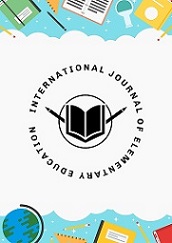Learning Environment and Learning Facilities: Numeracy Literacy for Class V Elementary School Students during the Pandemic
DOI:
https://doi.org/10.23887/ijee.v7i2.58015Keywords:
Learning Environment, Learning Facilities, Numeracy LiteracyAbstract
The numeracy literacy of Indonesian students could be higher. Complete learning facilities can support the achievement of student learning outcomes. This study aims to analyze the effect of the learning environment and learning facilities on students' numeracy literacy. This type of research is quantitative with ex-post facto research methods with a survey design. The overall population consists of 24 state primary schools with a total of 523 students. The sampling technique uses cluster sampling. Methods of data collection through questionnaires/questionnaires, questions and document study. The instrument used in this research is a questionnaire. Data analysis in this study uses a simple regression analysis model and multiple regression. The results showed that the learning environment negatively and significantly affected the numeracy literacy of fifth-grade elementary school students. The state of the learning environment around students is quite good, but the response in the form of numeracy literacy learning results is low. Second, the learning environment and facilities influence students' numeracy literacy. Third, the learning environment and facilities negatively and significantly affect numeracy literacy.
References
Anwar, N. T. (2018). Peran Kemampuan Literasi Matematis pada Pembelajaran Matematika Abad-21. Prosiding Seminar Nasional Matematika, 1, 364–370.
Asih, D. A. S. (2017). Pengaruh penggunaan fasilitas belajar di lingkungan alam sekitar terhadap keterampilan proses sains. Formatif: Jurnal Ilmiah Pendidikan MIPA, 7(1). https://doi.org/10.30998/formatif.v7i1.1331.
Buchanan, J., Pressick-Kilborn, K., & Maher, D. (2019). Promoting environmental education for primary school-aged students using digital technologies. Eurasia Journal of Mathematics, Science and Technology Education, 15(2). https://doi.org/10.29333/ejmste/100639.
Crismono, P. C. (2017). Pengaruh Outdoor Learning Terhadap Kemampuan Berpikir Kritis Matematis Siswa The Influence Of Outdoor Learning On The Mathematical Critical Thinking Skills Of Students. Junal Pendidikan Matematika dan Sains, 4(2), 106–113. https://doi.org/10.21831/jpms.v5i2.15482.
Dina, Z. H., Ikhsan, M., & Hajidin, H. (2019). The Improvement of Communication and Mathematical Disposition Abilities through Discovery Learning Model in Junior High School. JRAMathEdu (Journal of Research and Advances in Mathematics Education), 4(1), 11–22. https://doi.org/10.23917/jramathedu.v4i1.6824.
Elsayed, S. A., & Al-Najrani, H. I. (2021). Effectiveness of the Augmented Reality on Improving the Visual Thinking in Mathematics and Academic Motivation for Middle School Students. Eurasia Journal of Mathematics, Science and Technology Education, 17(8), 1–16. https://doi.org/10.29333/ejmste/11069.
Fauzy, A., & Nurfauziah, P. (2021). Kesulitan Pembelajaran Daring Matematika pada Masa Pandemi COVID-19 di SMP Muslimin Cililin. Jurnal Cendekia, 5(1). https://doi.org/10.31004/cendekia.v5i1.514.
Habibi, H., & Suparman, S. (2020). Literasi Matematika dalam Menyambut PISA 2021 Berdasarkan Kecakapan Abad 21. JKPM (Jurnal Kajian Pendidikan Matematika), 6(1), 57. https://doi.org/10.30998/jkpm.v6i1.8177.
Hanesty, E., Neviyarni, N., & Karneli, Y. (2020). Factors affecting student learning motivation during the Covid-19 pandemic. International Journal of Applied Counseling and Social Sciences, 02(1), 100–107. https://doi.org/10.24036/005404ijaccs.
Hartanto, H., & Sukartono, S. (2022). Pengaruh Fasilitas Belajar dan Pengelolaan Kelas terhadap Hasil Belajar Matematika Siswa Sekolah Dasar. Jurnal Basicedu, 6(4). https://doi.org/10.31004/basicedu.v6i4.3201.
Irfan, M., Kusumaningrum, B., Yulia, Y., Widodo, S. A., Info, A., Learning, O., & Learning, M. (2020). Challenges During the Pandemic: Use of E-Learning in Mathematics Learning in Higher Education. Infinity: Journal of Mathematics Education, 9(2), 147–158. https://doi.org/10.22460/infinity.v9i2.p147-158.
Istiandaru, A., Istihapsari, V., Wardono, W., & Mulyono, M. (2015). Problem Based Learning (PBL) Dengan Pendekatan Realistik-Saintifik dan Asesmen Pisa Untuk Meningkatkan Kemampuan Literasi Matematika. Edumatica: Jurnal Pendidikan Matematika, 5(11). https://doi.org/10.22437/edumatica.v5i01.2670.
Istirohah, I., Ratnaningsih, A., & Anjarini, T. (2022). Hubungan Suasana Lingkungan Belajar dengan Kecerdasan Matematis-Logis Siswa. Jurnal Educatio FKIP UNMA, 8(1). https://doi.org/10.31949/educatio.v8i1.1447.
Laurens, T., Batlolona, F. A., Batlolona, J. R., & Leasa, M. (2018). How Does Realistic Mathematics Education ( RME ) Improve Students ’ Mathematics Cognitive Achievement ? EURASIA Journal of Mathematics, Science and Technology Education, 14(2), 569–578. https://doi.org/10.12973/ejmste/76959.
Mandey, S. (2021). Pengaruh Fasilitas Belajar di Rumah terhadap Prestasi Belajar Peserta Didik Kelas Tinggi di SD Inpres Tara-Tara 2. Jurnal Ilmiah Wahana Pendidikan, 7(5). https://doi.org/10.5281/zenodo.5546605.
Nugrahanto, S., & Zuchdi, D. (2019). Indonesia PISA Result and Impact on the Reading Learning Program in Indonesia. International Conference on Interdisciplinary Language, Literature and Education, 373–377. https://doi.org/10.2991/icille-18.2019.77.
Nurlaily, V. A., Soegiyanto, H., & Usodo, B. (2019). Elementary school teacher’s obstacles in the implementation of problem-based learning model in mathematics learning. Journal on Mathematics Education, 10(2), 229–238. https://doi.org/10.22342/jme.10.2.5386.229-238.
Radiusman. (2020). Studi literasi: pemahaman konsep siswa pada pembelajaran matematika. FIBONACCI: Jurnal Pendidikan Matematika dan Matematika, 6(1), 1–8. https://doi.org/10.24853/fbc.6.1.1-8.
Rahmawati, A. D., Fakhriyah, F., & Ermawati, D. (2021). Pengaruh Fasilitas Belajar terhadap Prestasi Belajar Siswa Kelas III SDN Tambaharjo 02. Jurnal Ilmiah Indonesia, 6(8). https://doi.org/10.36418/syntax-literate.v6i8.3872.
Safithri, R., Syaiful, S., & Huda, N. (2021). Pengaruh Penerapan Problem Based Learning (PBL) dan Project Based Learning (PjBL) Terhadap Kemampuan Pemecahan Masalah Berdasarkan Self Efficacy Siswa. Jurnal Cendekia : Jurnal Pendidikan Matematika, 5(1), 335–346. https://doi.org/10.31004/cendekia.v5i1.539.
Sappaile, B. I. (2010). Konsep Penelitian Ex-Post Facto. Jurnal Pendidikan Matematika, 1(2).
Sholihah, A. K., & Mufidah, N. (2021). Pengaruh Lingkungan dan Fasilitas Belajar terhadap Prestasi Belajar Siswa pada Mata Pelajaran IPS. JIIPSI, Jurnal Ilmiah Ilmu Pengetahuan Sosial Indonesia, 1(2). https://doi.org/10.21154/jiipsi.v1i2.256.
Siswanto, E., & Hidayati, D. (2020). Management Indicators of Good Infrastructure Facilities To Improve School Quality. International Journal of Educational Management and Innovation, 1(1), 69. https://doi.org/10.12928/ijemi.v1i1.1516.
Sitirahayu, S., & Purnomo, H. (2021). Pengaruh Sarana Belajar Terhadap Prestasi Belajar Siswa Sekolah Dasar. JIIP-Jurnal Ilmiah Ilmu Pendidikan, 4(3). https://doi.org/10.54371/jiip.v4i3.242.).
Skagerlund, K., Ostergen, R., Vastfjall, D., & Traff, U. (2019). How does mathematics anxiety impair mathematical abilities ? Investigating the link between math anxiety , working memory , and number processing. PLoS ONE, 14(1), 1–17. https://doi.org/10.1371/journal.pone.0211283.
Sumarwati, S., Fitriyani, H., Setiaji, F. M. A., Amiruddin, M. H., & Jalil, S. A. (2020). Developing mathematics learning media based on elearning using moodle on geometry subject to improve students’ higher order thinking skills. International Journal of Interactive Mobile Technologies, 14(4), 182–191. https://doi.org/10.3991/IJIM.V14I04.12731.
Tanudjaya, C. P., & Doorman, M. (2020). Examining higher order thinking in Indonesian lower secondary mathematics classrooms. Journal on Mathematics Education, 11(2), 277–300. https://doi.org/10.22342/jme.11.2.11000.277-300.
Tiwow, D., Salajang, S., & Damai, W. (2020). The Effect of Cooperative Learning Model of STAD to the Mathematics Understanding. Advances in Social Science, Education and Humanities Research, 438(Aes 2019), 279–282. https://doi.org/10.2991/assehr.k.200513.063.
Turgut, S., & Turgut, I. G. (2018). The effects of cooperative learning on mathematics achievement in Turkey: A meta-analysis study. International Journal of Instruction, 11(3), 663–680. https://doi.org/10.12973/IJI.2018.11345A.
Ulfa, Z. D., & Mikdar, U. Z. (2020). Dampak Pandemi Covid-19 terhadap Perilaku Belajar, Sosial dan Kesehatan bagi Mahasiswa FKIP Universitas Palangka Raya. JOSSAE : Journal of Sport Science and Education, 5(2), 124. https://doi.org/10.26740/jossae.v5n2.p124-138.
Umaroh, U., & Pujiastuti, H. (2020). Analisis Kemampuan Representasi Matematis Siswa dalam Mengerjakan Soal PISA Ditinjau dari Perbedaan Gender. Jurnal Pendidikan Matematika Raflesia, 05(02), 40–53. https://doi.org/10.33449/jpmr.v5i2.11408.
Utaminingtyas, S., Subaryana., & Puspitasari, E. P. (2021). Pengaruh Motivasi Belajar dan Lingkungan Belajar terhadap Hasil Belajar Matematika. Jurnal Penelitian Pendidikan, 8(2). https://doi.org/10.25134/pedagogi.v8i2.4157.
Uyen, B. P., Tong, H. D., & Trem, N. T. (2019). Developing Mathematical Communication Skills for students in grade 8 in teaching congruent triangle topics. European Journal of Educational Research, 9(2), 445–455. https://doi.org/10.12973/eu-jer.10.3.1287.
Warshauer, H. K., Starkey, C., Herrera, C. A., & Smith, S. (2021). Developing prospective teachers’ noticing and notions of productive struggle with video analysis in a mathematics content course. Journal of Mathematics Teacher Education, 24(1), 89–121. https://doi.org/10.1007/s10857-019-09451-2.
Whyte, J., & Anthony, G. (2012). Maths Anxiety : The Fear Factor in The Mathematics Classroom. New Zealand Journal of Teachers’ Work, 9(1), 6–15.
Widiantari, K., & Suparta, I. N. (2022). Meningkatkan Literasi Numerasi dan Pendidikan Karakter dengan E-Modul Bermuatan Etnomatematika. Jurnal Ilmiah Pendidikan Matematika, 10(2), 331–343. https://doi.org/10.25273/jipm.v10i2.10218.
Widiarti, N. K., Sudarma, I. K., & Tegeh, I. M. (2021). Meningkatkan Hasil Belajar Matematika Kelas V SD Melalui Media Video Pembelajaran. Jurnal Edutech Undiksha, 9(2), 195. https://doi.org/10.23887/jeu.v9i2.38376.
Winata, A., Widiyanti, I. S. R., & Cacik, S. (2021). Analisis Kemampuan Numerasi dalam Pengembangan Soal Asesmen Kemampuan Minimal pada Siswa Kelas XI SMA untuk Menyelesaikan Permasalahan Science. Jurnal Educatio FKIP UNMA, 7(2). https://doi.org/10.31949/educatio.v7i2.1090.
Wiryanto. (2020). Proses Pembelajaran Matematika Di Sekolah Dasar Di Tengah Pandemi Covid-19. Jurnal Review Pendidikan Dasar: Jurnal Kajian Pendidikan dan Hasil Penelitian, 6(2), 125–132. https://doi.org/10.26740/jrpd.v6n2.p125-132.
Yuniarti, A., & Radia, E. H. (2020). Development of Comic Mathematics Teaching Materials on Flat- Building Material to Increase Reading Interest in Class IV Elementary School Students. Journal of Education Technology, 4, 415–423. https://doi.org/10.23887/jet.v4i4.30034.
Downloads
Published
How to Cite
Issue
Section
License
Copyright (c) 2023 Rizqi Amalia Berlianti

This work is licensed under a Creative Commons Attribution-ShareAlike 4.0 International License.
Authors who publish with the International Journal of Elementary Education agree to the following terms:
- Authors retain copyright and grant the journal the right of first publication with the work simultaneously licensed under a Creative Commons Attribution License (CC BY-SA 4.0) that allows others to share the work with an acknowledgment of the work's authorship and initial publication in this journal.
- Authors are able to enter into separate, additional contractual arrangements for the non-exclusive distribution of the journal's published version of the work (e.g., post it to an institutional repository or publish it in a book), with an acknowledgment of its initial publication in this journal.
- Authors are permitted and encouraged to post their work online (e.g., in institutional repositories or on their website) prior to and during the submission process, as it can lead to productive exchanges, as well as earlier and greater citation of published work. (See The Effect of Open Access)










